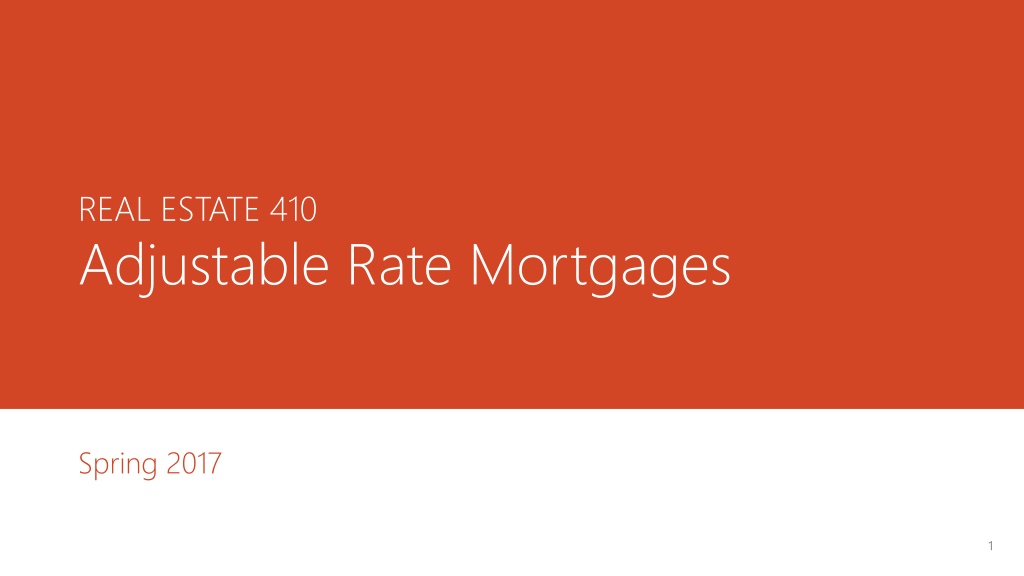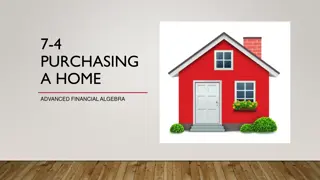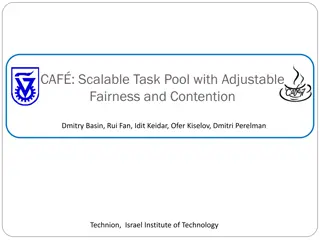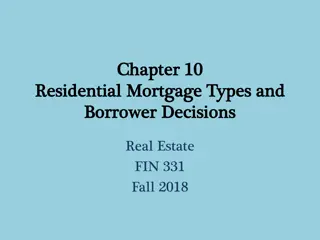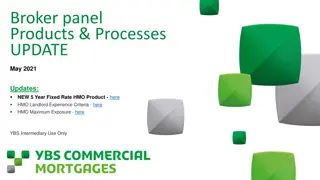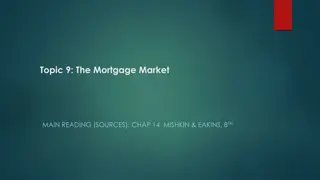Adjustable Rate Mortgages Overview
Adjustable Rate Mortgages (ARMs) involve sharing interest rate risk between borrower and lender. ARM rates fluctuate based on market conditions, offering lower initial rates compared to Fixed Rate Mortgages (FRMs). Learn about interest rate structures, risks, and benefits of ARMs.
Download Presentation

Please find below an Image/Link to download the presentation.
The content on the website is provided AS IS for your information and personal use only. It may not be sold, licensed, or shared on other websites without obtaining consent from the author.If you encounter any issues during the download, it is possible that the publisher has removed the file from their server.
You are allowed to download the files provided on this website for personal or commercial use, subject to the condition that they are used lawfully. All files are the property of their respective owners.
The content on the website is provided AS IS for your information and personal use only. It may not be sold, licensed, or shared on other websites without obtaining consent from the author.
E N D
Presentation Transcript
REAL ESTATE 410 Adjustable Rate Mortgages Spring 2017 1
Topics Adjustable rate mortgages (ARMs) ARMs vs. FRMs Interest rate caps and floors Payment caps Interest rate risk and ARM popularity Other adjustable rate mortgages 2
Review FRMs Lender bears the interest rate risk and of course is compensated for taking that risk. FRM products may then not be optimal for all borrowers Expected inflation is built into the interest rate. Product may not be suitable during periods of high expected inflation Short-term payment affordability issues (tilt effect) Prepayment risk is fully borne by the lender (or investor in MBS) and is of course priced into the mortgage. Again optimality issues! 3
Adjustable Rate Mortgages ARMs shift all or a portion of the interest rate risk back to the borrower by allowing for periodic interest rate adjustments (resets) as capital market conditions change. Borrower is compensated for taking on that risk since ARM rates are lower than similar FRM rates at origination. ARMs allow for interest rate risk sharing. The frequency of interest rate resets varies but are generally standardized. 4
Interest Rate Structure The contract interest on a adjustable mortgage loan rate is a composite interest rate equal to an index interest rate (i.e., the reference interest rate) plus a margin or spread. Interest rate = index interest rate + margin The index rate is generally an independent, market-determined base interest rate. U.S. treasury rate Average cost of funds index (COFI) of the 11th Federal Home Loan Bank (FHLB) Libor (London interbank offered rate) Home mortgage rate index 5
Interest Rate Structure ARM interest rates are therefore likely to change periodically as the index interest rate at resets to reflect current capital market conditions. However, the interest rate margin remains fixed throughout the term of the loan The shorter the time between periodic index interest rate resets, the more the interest rate risk borne by the borrower Thus, ARMs do not generally totally eliminate interest rate risk for either party. 7
Interest Rate Structure Interest margin Lender s compensation for the risk associated with the loan. 200-300 basis points (1 bp = 0.01%), but could be higher. Depends on borrower credit, property type, and loan structure. Extremely stable between lenders for most home mortgages and 1st-lien commercial mortgages. Interest rate resets Usually, 6 months to 1 year for home mortgages, but could vary from 1 month to up to 5 years. Initial interest rate generally fixed for 3, 5, 7, or 10 years (hybrids) Applicable new index rate usually is the last published rate before the reset date (e.g., 45 days before reset date.) 8
Teaser Rates Initial, temporarily reduced interest rates to make ARMs even more attractive for borrowers. Initial rate below market rate, leading to lower initial payments. Helps lower-income borrowers qualify for a mortgage. Future payment shock when interest rate resets to its normal level. Accrual rate or negative amortization? High refinancing rate (teaser chasers) It is not clear whether all residential borrowers comprehend or appropriately price the inherent risks in adjustable rate mortgages. 9
Repayment Terms Like FRMs and other mortgages, payments are monthly in arrears (i.e., at the end of month). ARMs are usually fully amortizing loanswith fixed term. Commercial mortgages generally structured with balloons at the end. At each interest reset, the new payment amount is computed by fully amortizing the loan balance for the remaining term using the new applicable rate. Periodic payments fluctuate with interest rates. Some ARM products are fully amortizing with leveled payments, but term cannot be fixed term then. 10
Interest Rate Caps ARMs benefit borrowers during falling interest rates. However, ARMs can inflict a lot of pain to borrowers during increasing interest rates. Interest rate caps limit the interest rate risk faced by the borrower. Interest rate caps fix the upper bounds for interest rate adjustments at interest rate resets or throughout the life of the loan. Lenders will often include caps in mortgages! Why? 11
Interest Rate Caps Types of interest rate caps: Periodic interest rate cap Lifetime interest rate cap What is the applicable interest rate at reset if the loan comes with both a periodic cap and lifetime cap? The minimum interest rate considering both periodic and life caps. Interest rate caps do not apply to the initial rate or the teaser rate, if any. Interest caps don t come free; borrowers must pay. 12
Interest Rate Floors Interest rate floors fix lower bounds for interest rate adjustments at resets or throughout the life of the loan, which benefits the lender. Lenders have to compensate the borrower for this benefit. Generally, interest rate floors are combined with caps to reduce the impact of caps on the interest rate. Important to note that interest rate adjustments do not necessary benefit or hurt lenders if the funding of the loan is done right (may be difficult though). Of course lenders will be hurt by lower interest rates if loans are funded with longer term money. 13
Payment Caps Payment caps are meant to reduce payment shocks, rather than interest rate shocks. Payment caps are limits on changes in periodic payments between interest rate resets, rather than interest rate changes. Therefore, payment caps provide temporally relief to the borrower. Careful, payment caps can result in negative amortization since unpaid interest added to the loan balance. Payment caps may not work during prolonged rising interest rates. 14
Other Terms Discount points Similar uses as for FRMs. Prepayment options: Prepayment penalties generally not charged for most residential ARMs but charged for commercial mortgages. Why? Lockout period: Prohibition to prepay for some years. But borrower may always negotiate with the lender. Conversion option Ability to switch to a FRM after a specific period of time. 15
Hybrid ARMs Hybrid ARMs structures sit in between FRMs and traditional ARMs. Widely used! Why? Applicable initial interest rate is fixed for an extended period of time and then fluctuates with the market. Initial reset period longer than for traditional ARMs (up to 10 years). For 3/1, 5/1, 7/1, or 10/1 ARMs, initial interest rates are fixed for 3, 5, 7, or 10 years and then fluctuate annually thereafter. 16
Interest-Only ARMs I.O. for initial period. The payment of interest and amortization of principal after the initial period will depend on the type of real estate and negotiations between the borrower and the lender. Fully amortizing payments required after initial period Pay interest and some principal Pay interest only Sometimes negative amortization Used more in commercial lending. 17
Pricing Considerations The expected yield (cost) of ARMs generally is a function of these factors: Initial interest rate Index and margin Any points charged Frequency of payment resets Inclusion of caps or floors on the interest rate, payments, or loan balances (more rare) It is important to understand how each of these factors affects default risk alone and in combination with other factors. Analysis is more difficult with ARMs! APR has no real meaning for ARMs! 18
Pricing Considerations Default risk Can borrower afford higher payments? Check income tests using upper limit rates. Impact of payment shocks and possible negative amortization? Likelihood of default risk of specific borrowers Income risk (volatility) Interest Rate Allocation of interest rate risk between the borrower and the lender. The party more able to bear the risk should bear it! 19
Interest Rate Risk, Default Risk, and Risk Premiums: ARMs vs. FRMs 20
Interest Rate Risk, Default Risk, and Risk Premiums: ARMs vs. FRMs 21
FRMs v. ARMs 1. At origination, expected yields on ARM loans should be lower than on FRMs. Provided that the increase in default for an ARM is lower than the reduction in interest rate risk. 2. ARMs tied to short-term indices are generally riskier for borrowers than ARMs tied to long-term indices. This is about interest rate volatility, not the reset period! 3. Also, more frequent interest rate resets make ARMs riskier for the borrower. At the extreme, borrowers should prefer non-adjusting mortgages. 22
FRMs v. ARMs 4. Interest rate caps reduce interest rate risk for borrowers, which results in higher required yield by lenders. On the other hand, interest rate floors reduces exposure to interest rate risk for lenders, thus lowering required yield. Caps can reduce default risk by limiting payment shocks. Floors can be used by borrowers to balance out the cost associated with interest rate caps. 5. Payment caps do not necessarily reduce interest rate risk for borrowers because any reduction in payment will add to the loan principal (negative amortization), but reduce default risk. 23
Example 1 An unrestricted, fully amortizing ARM (with no caps or floors) of $100,000 for 30 years with 1-year interest rate resets and monthly payments. The starting interest rate (index/reference rate + margin and any teaser discount) is 5%. 1. What is the initial payment? To compute the initial (or any payment for that matter), assume that the beginning of period rate applies to the remaining loan tenor. PV = $100,000; n = 360; FV = $0; i = 5/12 Then, PMT = $536.82 24
Example 1 2. If the composite rate increase to 7% at the end of year 1, what is the new payment amount? First, compute the outstanding balance at the end of year 1; use the PV method (always easier!) PMT = $536.82; n = 348; FV = $0; i = 5/12 Then, OBL12 = PV = $98,524.63 Now compute the new payment by assuming that the new rate applies for the remainder of the loan. PV = $98,524.63; n = 348; FV = $0; i = 7/12 Then, PMT = $662.21 25
Example 1 Note the payment increase: $662.21 - $536.82 = $125.39 This is a 23.4% payment increase! This could be a problem for a borrower on a tight budget. 26
Example 2: Rate Cap A fully amortizing ARM of $100,000 for 30 years with 1-year interest rate resets, monthly payments. The starting interest rate is now 7% with a 2% annual interest rate cap. 1. What is the initial payment? The rate cap does not affect the initial payments. PV = $100,000; n = 360; FV = $0; i = 7/12 Then, PMT = $665.30 The outstanding balance at the end of year 1 is $98,984.19 (do the calculation!). 27
Example 2: Rate Cap 2. Compute the 2nd year payments if the composite rate at the end of year 1 is 8% and 10%. The applicable interest rate in year 2 cannot be more than the previous year s rate plus the annual rate cap, i.e., 7% + 2% = 9% (upper limit in year 2). If the composite rate is 8%, then the applicable rate will be 8% and the 2nd year payments will be $732.43. If the composite rate is 10%, then the applicable rate will be 9% and the 2nd year payments will be $801.93. The payment would have been $873.51 without the interest cap, almost 9% higher. 28
Example 3: More Rate Caps Consider a $250,000 1-year ARM at a margin of 2% over Libor with monthly payments and a 30-year term. 1. What is the periodic payment amount for the 1st year if Libor is at 3% at origination? PV = $250,000; FV = 0; i = (3%+2%)/12; n =360 Therefore, PMT=$1,342.05 29
Example 3: More Rate Caps 2. Suppose the index (Libor) increases to 7% at the end of yr 1. What is the payment amount during the 2nd year if loan has a 2% periodic interest rate cap and a 4% lifetime cap? Outstanding balance at end of year 1: PMT = $1,342.05; FV = 0; i = 5%/12; n = 348. Therefore, OLB12 = $246,311.59 30
Example 3: More Rate Caps Find the applicable interest rate for year 2: Min (5%+2%, 5%+4%, 7%+2%) = 7% Periodiccap Lifetime cap Period s index + margin Compute the monthly payment for year 2: PV = $246,311.59; FV = 0; i = 7%/12; N=348 PMT = $1,655.53 31
Example 3: More Rate Caps 3. Libor is now 11% at the end of year 2, compute monthly payment for 3rd year. Outstanding balance at end of year 2: PMT = $1,655.53; FV = 0; i = 7%/12; n = 336 OLB24= $243,601.13 Interest rate in year 3: Min (7%+2%, 5%+4%, 11%+2%) = 9% Monthly payments in year 3: PV = $243,601.13; FV = 0; i = 9%/12; n = 336 PMT = $1,988.52 32
Example 4: Payment Cap An fully amortizing 1-year ARM of $100,000 for 30 years with monthly payments and a 5% payment cap. The starting interest rate is 6%. 1. What is the initial payment? PV = $100,000; n = 360; FV = $0; i = 6/12 PMT = $599.55 The outstanding balance at the end of year 1 is $98,771.99 (do the calculation!). 33
Example 4: Payment Cap 2. What are next year s payments if the composite rate at the end of year 1 is 10%? The unrestricted payment without the payment cap would be: PV = $98,771.99; n = 348; FV = $0; i = 10/12 Thus, PMT = $871.64 But given the cap, the 2nd year periodic payments cannot be more than: $599.55*1.05% = $629.53 34
Example 4: Payment Cap The payment cap will be binding in this instance. The difference between the unconstrained payment amount and the capped amount will be added to the principal every month, resulting in a negative amortization. The principal outstanding at the end of year 2 will be: PV = $98,771.99; n= 12; PMT= ($629.53); i = 10/12 OLB24= FV= $101,204.32 As expected, this is more than the starting loan balance due to the negative amortization. 35
Typical ARM Indexed to Treasury bill rate or LIBOR. Rate and payments adjusted annually with rate adjustments limited by annual caps of 2% to 6% over the life of the loan. Maximum LTV ratio 95%; PMI required when LTV ratio is 80- 95%. 30-year loan term. Fully amortized, with negative amortization not permitted. 36
ARMs Compared to FRMs No fixed interest rates or predetermined payment patterns for life. For ARMs, Prepayment is usually not a major issue, except for non-prime home mortgages and commercial mortgages. Risk sharing between the borrower and the lender. The level of risk sharing depend on the frequency interest rate resets. The more frequent the resets the more the interest risk shifts to the borrower. ARMs do not completely eliminate interest rate risk for the lender 37
Risk Tradeoff As noted, ARMs allow lenders to partially shift interest rate risk to borrowers. As a borrower bears more interest rate risk, default risk is likely to increase as well! The lender may be in a better position to bear that risk than the borrower. ARMs involve therefore a tradeoff between interest rate risk and default risk. The lender must consider these two key aspects: Will the borrower be able to make the monthly payments if interest rates increase? In case of a default, will the value to the property be greater than the loan balance? 1. 2. 38
Factors to Consider When deciding between a FRM and an ARM, the borrower (as well as the lender) should consider: Income level (ability to withstand payment shocks) Income volatility Mobility Risk attitude Expectations about future interest rates Refinancing option of FRMs 39
Some Stats 40
Past FRM & ARM Rates Interest rates that would have been paid on FRM & ARM Loans over the 5- year period starting in January 1999 45
Past FRM & ARM Rates Interest rates that would have been paid on FRM & ARM Loans over the 5- year period for different starting dates 46
30-Year FRM Rates Fixed Rate Mortgage Interest Rates (Monthly Freddie Mac Data) 20 18 16 14 12 10 8 6 4 Source: Federal Reserve Bank of St Louis FRED database This is why Greenspan said in back in 2005 that more people should have chosen ARMs in the previous 10 years! 47
Interest Rate Risk & ARM Popularity Source: Mortgage Market Design by John Y. Campbell 48
FRM Maturities Source: Mortgage Market Design by John Y. Campbell 49
Interest Rate Risk An inaccurate prediction of interest rate due to inflation higher than expected would result in a loss for the lender. Interest rate risk has probably the largest impact on profitability. Often though, the lender is better able to manage that risk than the borrower. Assume a CPM mortgage contract involves i=10%, $600,000, 30 years, repaid after 10 years. What is the loss to the lender would suffer if the market rate moves up to 12% shortly after closing? 50
